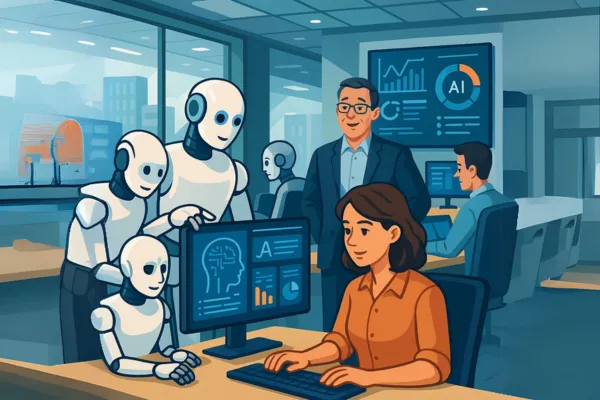
Why Humans Outshine AI in Emotional Intelligence at Workplaces
Why Humans Outshine AI in Emotional Intelligence at Workplaces
In today's rapidly evolving job market, the integration of artificial intelligence (AI) into the workplace is inevitable. While AI brings remarkable efficiencies and capabilities, there's a growing conversation surrounding its limitations, especially in domains that require emotional intelligence. Despite various advances, AI still falls short when compared to humans in contextually understanding and empathizing, which are essential components of emotional intelligence in workplaces.
The Rise of AI in the Workplace
The incorporation of AI technologies into businesses has led to significant transformations. From automating mundane tasks to providing advanced data analytics, AI has become an invaluable asset for many companies. Some of the benefits businesses have already noticed include:
Increased efficiency and productivity
Reduction in human errors
24/7 availability and operational capabilities
However, with these advancements, a question arises: Can AI replace human roles that require emotional interactions? The short answer is no. Humans inherently possess an ability to intuitively process and respond to emotional cues and complex social dynamics that AI cannot match. Let's delve deeper into why that’s the case.
The Strengths of Human Emotional Intelligence
1. Intuitive Understanding of Emotions
Humans have a natural ability to perceive and interpret emotions, both facial and tonal. This allows for a unique emotional connection that AI simply cannot replicate. For example, an empathetic smile or a tone of voice can offer comfort and understanding that outshines any machine's programmed responses.
2. Adaptability to Context
Situations in the workplace are dynamic and often unpredictable. Humans excel at adapting their emotional responses based on context. Whether it's knowing when humor is appropriate in a stressful meeting or offering listening support during a colleague's crisis, humans adjust their emotional responses naturally. AI, on the other hand, operates on predefined algorithms and lacks this ability to truly adapt.
3. Cultural Sensitivity
In diverse workplaces, cultural nuances play a vital role in communication. Emotional intelligence involves understanding these nuances and engaging with empathy. While AI can be programmed to recognize specific cultural signals, it doesn't grasp the subtleties that come with real-world interactions, which can lead to potential misunderstandings.
The Limitations of AI in Emotional Intelligence
1. Lack of Genuine Empathy
AI systems lack the ability to truly empathize. Genuine empathy stems from a shared human experience that AI cannot access. It’s one thing for AI to recognize that a person is upset, and quite another to emotionally resonate with that person, offering comfort in a way that feels sincere.
2. Misinterpretation of Complex Emotions
Human emotions are often complex and multi-layered. Emotionally intelligent humans can read between the lines and understand underlying emotions and intentions, something AI struggles with. An AI might misinterpret sarcasm as a serious comment or fail to recognize subtle signs of distress in a colleague.
3. Inability to Build Trust
Trust is the foundation of any meaningful workplace relationship, and it is inherently built on emotional connections. While AI can perform tasks reliably, it does not inspire trust in the same way human colleagues do. This lack of trust limits the extent to which employees can feel genuinely supported by AI systems.
The Balance Between AI and Human Emotional Intelligence
The limitations of AI do not suggest that it is redundant. Instead, it points to a future where AI complements rather than replaces the human workforce. By leveraging AI for tasks that require efficiency and precision, humans can focus on fostering workplace environments that thrive on emotional intelligence. Such a synergy can promote both productivity and employee well-being.
Enhancing Human Roles in AI-Driven Workplaces
Organizations can benefit greatly from investments in technology that also enhance human roles. Some strategic approaches include:
Training programs: Develop and reinforce emotional intelligence skills among employees to enhance interpersonal interactions.
Hybrid roles: Create positions that merge AI efficiency with human empathy, enabling seamless collaboration.
Feedback loops: Implement systems where employees can give feedback on AI performance, ensuring that such systems are continuously refined for better integration.
Conclusion
While AI is revolutionizing how tasks are carried out at workplaces, it cannot replicate the inherently human capabilities of emotional intelligence. Businesses must recognize the unique strengths that humans bring to the table in fields demanding empathy, cultural sensitivity, and trust-building. By adopting an integrated approach where both AI and humans interact symbiotically, companies can harness the best of both worlds to cultivate environments in which innovation and emotional intelligence coexist harmoniously.
The future is not about choosing between AI and human emotional intelligence but rather embracing their combined potential. To stay competitive and foster active engagement, businesses must not only focus on technological advancements but also prioritize and nurture the emotional skills that help humans outshine AI in workplaces.

